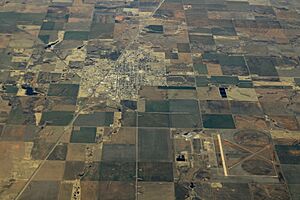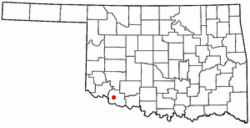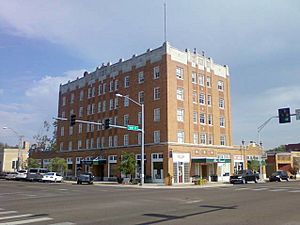Frederick, Oklahoma facts for kids
Quick facts for kids
Frederick, Oklahoma
|
|
|---|---|

Aerial view of Frederick
|
|

Location of Frederick within Oklahoma
|
|
| Country | United States |
| State | Oklahoma |
| County | Tillman |
| Government | |
| • Type | Council-Manager |
| Area | |
| • Total | 4.96 sq mi (12.84 km2) |
| • Land | 4.95 sq mi (12.81 km2) |
| • Water | 0.01 sq mi (0.03 km2) |
| Elevation | 1,237 ft (377 m) |
| Population
(2020)
|
|
| • Total | 3,468 |
| • Density | 701.03/sq mi (270.68/km2) |
| Time zone | UTC-6 (CST) |
| • Summer (DST) | UTC-5 (CDT) |
| ZIP code |
73542
|
| Area code | 580 |
| FIPS code | 40-27800 |
| GNIS feature ID | 2410541 |
Frederick is a city in Oklahoma, United States. It is the main town, or county seat, of Tillman County. In 2020, about 3,468 people lived there. Frederick is an important farming community. It mainly produces wheat, cotton, and cattle.
Frederick is also home to three dairies. It has a large industrial park and the Frederick Regional Airport. This airport has old World War II hangars. These hangars now house the World War II Airborne Demonstration Team. In April 1905, then U.S. President Theodore Roosevelt visited Frederick. He came for a wolf hunt.
Contents
Frederick's History
Frederick started in 1901. This area was one of the last parts of Oklahoma Territory to be opened for people to settle. What is now Frederick used to be two separate towns. These towns were called Gosnell and Hazel. Both towns began in 1901. This was when the Kiowa-Comanche-Apache reservation land became available.
In 1902, Gosnell and Hazel joined together. They did this to benefit from the Blackwell, Enid and Southern Railroad. The new combined town was named Frederick. It was named after the son of a railroad executive. Gosnell got the train depot. The people from Hazel moved north to the new town of Frederick. The post office also moved and was renamed Frederick in 1902.
Early Challenges and Growth
Most of the business area was destroyed by fires. These fires happened in 1904 and 1905. The buildings were made of wood. They were quickly rebuilt using brick.
In the spring of 1905, President Teddy Roosevelt visited Frederick. He met with Jack "Catch-'em-alive" Abernathy. Jack was famous for hunting wolves without weapons. This visit helped bring tourism to the area. In 1907, Frederick officially became a city. Oklahoma also became a state that year. Frederick was chosen as the county seat for Tillman County. The Katy Railroad also arrived in Frederick.
By 1915, Frederick had 15 miles of sidewalks. It also had 75 miles of wide, well-kept streets. The first paved streets were built in 1918.
Frederick Army Air Field
The Frederick Army Air Field opened in 1941. It trained pilots to fly UC-78 transport planes and B-25 bombers. In 1953, the base was given to the City of Frederick. It is now the Frederick Municipal Airport and Industrial Park. In 1962, a flagpole was put up in Pioneer Park. This fulfilled an old agreement between Gosnell, Hazel, and the railroad.
Geography of Frederick
Frederick is located where U.S. Route 183 and Oklahoma State Highway 5 meet. The city covers about 5.0 square miles (12.8 square kilometers). Most of this area is land.
Lake Frederick is owned by the town. It is about 15 miles northeast of the city.
Frederick's Climate
| Climate data for Frederick, Oklahoma | |||||||||||||
|---|---|---|---|---|---|---|---|---|---|---|---|---|---|
| Month | Jan | Feb | Mar | Apr | May | Jun | Jul | Aug | Sep | Oct | Nov | Dec | Year |
| Record high °F (°C) | 90 (32) |
93 (34) |
98 (37) |
101 (38) |
107 (42) |
114 (46) |
114 (46) |
117 (47) |
111 (44) |
103 (39) |
93 (34) |
86 (30) |
117 (47) |
| Mean daily maximum °F (°C) | 53 (12) |
60 (16) |
68 (20) |
81 (27) |
84 (29) |
93 (34) |
97 (36) |
98 (37) |
90 (32) |
79 (26) |
65 (18) |
55 (13) |
77 (25) |
| Mean daily minimum °F (°C) | 29 (−2) |
33 (1) |
39 (4) |
49 (9) |
58 (14) |
67 (19) |
71 (22) |
70 (21) |
63 (17) |
52 (11) |
40 (4) |
31 (−1) |
50 (10) |
| Record low °F (°C) | −8 (−22) |
−5 (−21) |
3 (−16) |
23 (−5) |
35 (2) |
43 (6) |
52 (11) |
48 (9) |
34 (1) |
17 (−8) |
9 (−13) |
— | −8 (−22) |
| Average precipitation inches (mm) | 1.1 (28) |
1.2 (30) |
1.7 (43) |
2.6 (66) |
4.5 (110) |
2.9 (74) |
2.2 (56) |
2.1 (53) |
2.6 (66) |
3 (76) |
1.5 (38) |
1.4 (36) |
26.8 (680) |
| Average snowfall inches (cm) | 2.2 (5.6) |
1.4 (3.6) |
1.2 (3.0) |
0.2 (0.51) |
0.2 (0.51) |
1.5 (3.8) |
— | — | — | — | — | — | 6.7 (17) |
| Average rainy days | 3 | 3.2 | 4.4 | 5.7 | 7 | 5.4 | 4.5 | 4.3 | 4.5 | 5 | 2.9 | 3.5 | 53.4 |
| Average relative humidity (%) | 74 | 74 | 68 | 63 | 65 | 62 | 57 | 50 | 55 | 62 | 60 | 72 | 64 |
| Source 1: weather.com | |||||||||||||
| Source 2: Weatherbase.com | |||||||||||||
Population Changes in Frederick
| Historical population | |||
|---|---|---|---|
| Census | Pop. | %± | |
| 1910 | 3,027 | — | |
| 1920 | 3,822 | 26.3% | |
| 1930 | 4,568 | 19.5% | |
| 1940 | 5,109 | 11.8% | |
| 1950 | 5,467 | 7.0% | |
| 1960 | 5,879 | 7.5% | |
| 1970 | 6,132 | 4.3% | |
| 1980 | 6,153 | 0.3% | |
| 1990 | 5,221 | −15.1% | |
| 2000 | 4,637 | −11.2% | |
| 2010 | 3,940 | −15.0% | |
| 2020 | 3,468 | −12.0% | |
| U.S. Decennial Census | |||
In 2000, there were 4,637 people living in Frederick. These people lived in 1,797 households. About 30.5% of these households had children under 18. Many households were married couples living together. About 29.9% of households were individuals living alone. Some of these were people aged 65 or older.
The population was spread out by age. About 27.1% were under 18 years old. About 20.8% were 65 years or older. The average age in the city was 38 years.
Education in Frederick
Great Plains Technology Center is located in Frederick. Frederick is served by Frederick Public Schools. This includes a high school, a middle school, and an elementary school. The school sports teams are called the Bombers.
The Frederick High School football team won its first state championship in 1956. This team was special because it was inter-racial. In 2007, they were added to the Oklahoma Sports Hall of Fame. The teams were made up of students from Frederick High School and Boyd High School. The Frederick Bombers won state championships again in 1993, 1994, 1995, and 1996.
The school colors have changed over time. In the 1950s, they were maroon and gray. In the late 1960s, they changed to red and white. In the late 1980s, black was added to the red and white.
Historical Sites to Visit
Frederick has several places listed on the National Register of Historic Places. These sites are important parts of the city's past.
- The Ramona Theatre: This theater was built in 1929. It is a great example of Spanish Colonial style. Inside, you can see electric twinkling stars. There are also special effects that make rolling clouds move across a blue plaster sky.
- Tillman County Courthouse: This building was constructed in 1921. It has three stories and looks like it's made of cut stone. The north side has a unique curved wall. It shows how architects mixed different classical styles.
- J.D. Laney House: This is a one-story Craftsman-style bungalow. John David Laney built it in 1928-1929 as the main house on his farm. The house was built using different types of local stone. These included granite, sandstone, and limestone.
Culture and Community
Frederick hosts the annual Oklahoma Cotton Festival in September. The Frederick Public Library is still in use today. It was first funded in 1915 by the Carnegie Foundation.
The Tillman County Historical Society has a Pioneer Heritage Townsite Center. It features the old railroad depot and other historic buildings.
There is a life-size statue in Pioneer Park. It honors Louis and Temple Abernathy. These two boys from Frederick became famous in 1910. They were only 6 and 10 years old. They rode alone on horseback from Frederick to Washington, DC. They visited President Taft. Then they rode to New York City. There, they greeted former President Theodore Roosevelt when he returned from an African trip.
Notable People from Frederick
- Newby O. Brantly (1905–1993), an inventor and business person.
- Bob Bryant (1918–2000), a professional football player.
- Alyce Faye Eichelberger Cleese (born 1944), a psychotherapist and author.
- Charles Collins (1904–1999), an actor in films and on Broadway.
- Glenn Dobbs (1920–2002), a professional football player and coach.
- Anthony M. Massad (1920–2017), an Oklahoma state senator and lawyer.
- Buddy Ryan (1931–2016), a football player and coach. He created the 46 defense.
See also
 In Spanish: Frederick (Oklahoma) para niños
In Spanish: Frederick (Oklahoma) para niños


